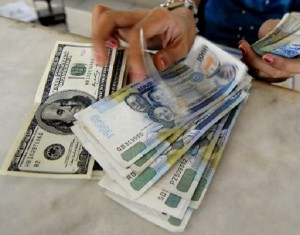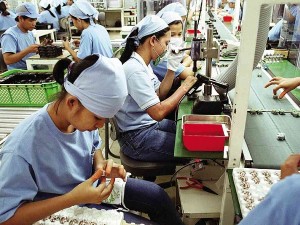
The peso is expected to continue depreciating in the near term as the dollar rallies against all currencies due to the recovery in the American economy, posing a threat to the Philippines’ own performance this year. AFP FILE PHOTO
MANILA — The peso on Wednesday shed one centavo against the greenback to close at 49.86:$1, slipping to a fresh eight-year low.
But also on Wednesday, Bangko Sentral ng Pilipinas Governor Amando M. Tetangco Jr. said there was no need to worry as the weaker emerging market currencies such as the peso have been among the global phenomenon amid the sustained strength of the US dollar.
The peso closed at its weakest level since Nov. 20, 2008’s 49.999:$1.
At the Philippine Dealing System, the domestic currency hit an intraday low of 49.94:$1 and a high of 49.82:$1.
The total volume traded dropped to $360.5 million from $520 million last Tuesday.
“Basically, the weakness in emerging market currencies is due to dollar strength. And why is that so? Because of expectations that interest rates are going to rise in the US. And because as the [incoming Trump] administration pushes for increased spending and more rapid economic growth, that may result in higher inflation and therefore higher interest rates. Because of that, we are seeing the flow of capital out of emerging markets and back to the United States,” Tetangco explained to reporters on the sidelines of the Security Bank Economic Forum 2016.
“If you look at the movements of Asian regional currencies, the Philippine peso is basically in the middle of the range in terms of both the actual movement, meaning depreciation since the beginning of the year, as well as in terms of volatility of exchange rate movements. As I have mentioned, we are sticking to our current foreign exchange policy of allowing market forces to basically determine the exchange rate. But at the same time, we also do not want to see the exchange rate becoming out of line. And we don’t want to see too much volatility in exchange rate movements such that this can cause the disanchoring of the expectations,” Tetangco added.
Despite a weakening peso, Tetangco said on Wednesday that the economy was in a “good position at this point.”
“If you look at our macroeconomic fundamentals, we grew 7.1 percent in the third quarter. Our inflation rate in October is 2.3 percent; the average for the first 10 months is 1.6 percent. And the reserves continue to be at the comfortable level. The banking system is sound and able to provide for the credit requirements of the corporate sector as well as the other sectors of the economy,” the BSP chief pointed out. SFM


